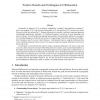1777 search results - page 194 / 356 » Programming Cryptographic Protocols |
SIGSOFT
2007
ACM
14 years 10 months ago
2007
ACM
Asynchronous systems components are hard to write, hard to reason about, and (not coincidentally) hard to mechanically verify. In order to achieve high performance, asynchronous c...
EMSOFT
2006
Springer
14 years 1 months ago
2006
Springer
Distributed real-time systems require a predictable and verifiable mechanism to control the communication medium. Current real-time communication protocols are typically independe...
ASPLOS
2008
ACM
14 years 2 days ago
2008
ACM
Integrating more processor cores on-die has become the unanimous trend in the microprocessor industry. Most of the current research thrusts using chip multiprocessors (CMPs) as th...
EUROCRYPT
2004
Springer
14 years 3 months ago
2004
Springer
Informally, an obfuscator O is an efficient, probabilistic “compiler” that transforms a program P into a new program O(P) with the same functionality as P, but such that O(P)...
WDAG
2005
Springer
14 years 3 months ago
2005
Springer
Transactional Memory is a concurrent programming API in which concurrent threads synchronize via transactions (instead of locks). Although this model has mostly been studied in the...

